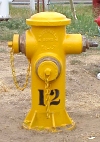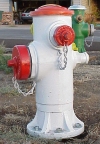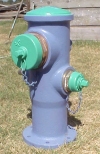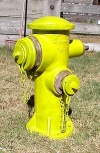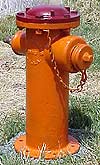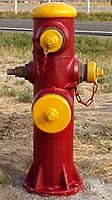© 2000 Capt. Willis Lamm, Water Supply Officer, Moraga-Orinda (CA) Fire DistrictBackground Criteria Storage Distribution Hyd. Design Placement Installation Codes & Markings Applications Codes & Standards
|
| COLOR CODES AND MARKINGS |
|
Body Colors:
Since they are needed upon an immediate basis during an emergency, fire hydrants should be immediately recognizable to fire fighting forces as well as to the general public. The National Fire Protection Association (NFPA) specifies that fire hydrants are to be painted chrome yellow, however it accepts other body colors which were already in use at the time the standard was adopted in the 1970s. Other highly visible colors which have been used include white, bright red, chrome silver and lime-yellow. In jurisdictions where no standard color has been established, the most important aspect is consistency. Standard colors should be adopted which, preferably, are the same throughout the region. NFPA also recognizes that there are often functional differences in service provided by municipal and private hydrant systems. Therefore NFPA specifies that non-municipal hydrants be painted a color that distinguishes them from municipal hydrants. Furthermore, violet has been established as the international color code for non-potable water. Therefore hydrants supplied by non-potable sources should be painted violet (light purple). FireHydrant.Org recommends the following body colors for fire hydrants:
Flow Indicators The NFPA standard calls for bonnets and caps to be color-coded to indicate the hydrant's available flow at 20 p.s.i.
Standard color codes are as follows:
|
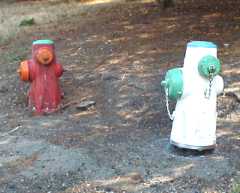
|
|
Additional NFPA Language reads:
Hydrants rated at less than 20 psi (1.4 bar) should have the rated pressure stenciled in black on the hydrant top. In addition to the painted top and nozzle caps, it may be advantageous to stencil the rated capacity of high volume hydrants on the top. The classification and marking of hydrants provided for in this chapter anticipate determination based on individual flow test. Where a group of hydrants can be used at the time of a fire, some special marking designating group-flow capacity may be desirable. Fire hydrants that are permanently inoperative or unusable should have barrels, nozzle caps, tops, and all visible parts painted black. Fire hydrants that are temporarily inoperative or unusable should be wrapped or otherwise provided with temporary indication of their condition. |
| Continue to Part 8 |
Return to Part 6
Return to Information Section
Return to Water Supply Page
Background Criteria Storage Distribution Hyd. Design Placement Installation Codes & Markings Applications Codes & Standards
|
